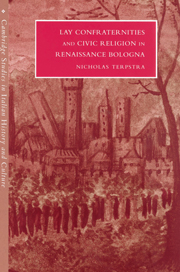Crossref Citations
This Book has been
cited by the following publications. This list is generated based on data provided by Crossref.
Cavallo, Sandra
1998.
Charity, Philanthropy and Reform.
p.
108.
Peterson, David S.
2000.
Out of the Margins: Religion and the Church in Renaissance Italy*.
Renaissance Quarterly,
Vol. 53,
Issue. 3,
p.
835.
Lowe, Kate
2001.
Elections of Abbesses and Notions of Identity in Fifteenth- and Sixteenth-Century Italy, with Special Reference to Venice*.
Renaissance Quarterly,
Vol. 54,
Issue. 2,
p.
389.
Tait, Clodagh
2002.
Death, Burial and Commemoration in Ireland, 1550–1650.
p.
30.
Guzzetti, Linda
and
Ziemann, Antje
2002.
Women in the Fourteenth-Century Venetian Scuole.
Renaissance Quarterly,
Vol. 55,
Issue. 4,
p.
1151.
Sarti, Raffaella
2005.
The true servant: Self-definition of male domestics in an Italian city (Bologna, 17th–19th centuries).
The History of the Family,
Vol. 10,
Issue. 4,
p.
407.
Carboni, Mauro
2008.
The Economics of Marriage: Dotal Strategies in Bologna in the Age of Catholic Reform.
The Sixteenth Century Journal,
Vol. 39,
Issue. 2,
p.
371.
Todeschini, Giacomo
2008.
The Self-Perception of Early Modern Capitalists.
p.
17.
2010.
A Flock Divided.
p.
239.
2010.
Contesting the Renaissance.
p.
213.
2010.
A Flock Divided.
p.
159.
2010.
A Flock Divided.
p.
1.
2010.
A Flock Divided.
p.
221.
2010.
A Flock Divided.
p.
281.
2010.
A Flock Divided.
p.
185.
2010.
A Flock Divided.
p.
17.
2010.
A Flock Divided.
p.
91.
2010.
A Flock Divided.
p.
55.
2010.
A Flock Divided.
p.
123.
Buylaert, Frederik
De Rock, Jelle
and
Van Bruaene, Anne-Laure
2015.
City Portrait, Civic Body, and Commercial Printing in Sixteenth-Century Ghent.
Renaissance Quarterly,
Vol. 68,
Issue. 3,
p.
803.





